Serve! What are the different cuisines in China?
Various local cuisines in China are folk cuisines with different characteristics in different regions, which are the main body of Chinese cuisine, relative to palace cuisines, government cuisines and temple cuisines. There are many local cuisines in China, including Beijing Cuisine, Shandong Cuisine, Sichuan Cuisine, Guangdong Cuisine, Huaiyang Cuisine, Zhejiang Cuisine, Fujian Cuisine, hubei cuisine Cuisine, Hunan Cuisine, Shanghai Cuisine and Tianjin Cuisine. Below, Xiaobian collected the characteristics of various local dishes in China, and gave you a detailed introduction.
First, Shandong cuisine
Shandong cuisine, Shandong cuisine, consists of Jinan, Jiaodong and Confucian cuisine.
Jinan cuisine pays special attention to soup making. There are strict regulations on the use and cooking of clear soup and milk soup. The dishes are famous for their freshness, crispness and tenderness.
Jiaodong cuisine originated in Fushan, Yantai and Qingdao, and is good at cooking seafood. Its taste is mainly fresh and tender, with emphasis on lightness and color.
Confucian cuisine is a concrete embodiment of "never tired of eating fine food, never tired of eating fine food", and its wide range of materials and rich banquet are comparable to those of imperial meals moved to imperial palaces in the past.
Shandong cuisine is very heavily seasoned, pure and mellow, with few complex synthetic flavors. It tries its best to reflect the original taste of raw materials. Another feature is that there are many kinds of pasta. Wheat, corn, sweet potato, soybean, sorghum and millet can all be made into pasta with different flavors, making it a famous feast.
Signature dishes: sweet and sour fish, sea cucumber with onion.
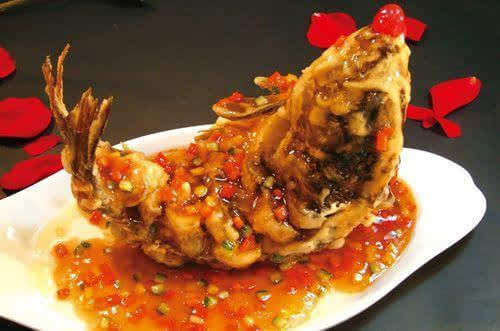
Sweet-and-sour fish
Ingredients: 1 carp, 1/2 carrot and 2 garlic moss.
Seasoning: 1/2 teaspoon of salt, 2 tablespoons of vinegar, 1 section of onion, 2 pieces of ginger, 2 cloves of garlic, 1 tablespoon of cooking wine, appropriate amount of starch, 1.5 teaspoons of tomato sauce, 4 tablespoons of vegetable oil, 3 teaspoons of sugar and appropriate amount of pepper.
Practice:
1. Remove scales, gills, viscera and wash the fish.
2. Use a knife to cut a knife diagonally in the direction of the fish head at intervals of about 3 cm.
3. Apply cooking wine, pepper and proper amount of salt evenly on the fish body and abdominal cavity, add shredded onion and ginger slices, and marinate for 20 minutes.
4. Dice the carrot and cut the garlic moss into 5 mm segments.
5. Add water to the starch to make a starch paste, rub it on the fish by hand, and also wipe the cut place (the starch paste should not be too thin, otherwise it will not hang).
6. Heat the oil in the pot. When it is 70% hot, hold the fish tail in one hand and pour the oil in the place of the cutting knife with the other hand until the fish is everted and shaped.
7. Put the fish in the pot and fry it on low heat until it is cooked (try not to turn over and prevent the fish from breaking. You can pour hot oil on the fish with a spoon. If you want the finished product to be placed with the abdomen down, put the abdomen down into the oil pan).
8. Raise the oil temperature, fry the fish in the pot again, fry the skin and put it in the plate.
9. Leave a little oil in the pot and stir-fry the diced vegetables.
10. Stir-fry the tomato sauce in the pot, pour in appropriate amount of boiling water, add sugar, vinegar and appropriate amount of salt.
11. After the sweet and sour juice is boiled, add a proper amount of water starch and burn it until it is thick. You can add some cooked oil to make the soup shiny.
12. Pour the sweet and sour juice evenly on the fish.
Second, Sichuan cuisine
Flavors include Chengdu, Chongqing, Leshan, Zigong and other local dishes.
The main feature is the variety of flavors and subtle changes. Pepper, pepper, pepper, bean paste and so on are the main condiments. With different proportions, various flavors such as spicy, hot and sour, pepper hemp, sesame paste, garlic paste, mustard, red oil, sweet and sour, fish flavor and strange taste are produced, all of which are thick and mellow, with the special flavor of "one dish in one box" and "all kinds of dishes are delicious".
Signature dishes: Fish-flavored shredded pork, kung pao chicken.
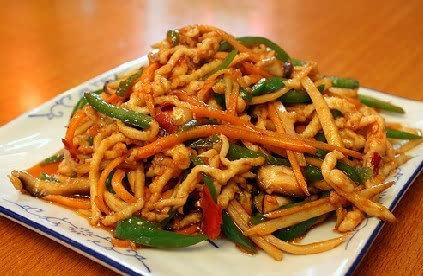
fried shredded pork with sweet and sour sauce
Ingredients: 400g pork, 10 fungus, 1 green pepper, 1 carrot, 1 chopped pepper, 2 Pixian bean paste, 1 rice vinegar, 1 soy sauce, half a spoon oyster sauce, 1 sugar, 1 water starch, minced garlic and shredded ginger.
Practice:
1. Shred pork, not too fine.
2. Carrots, green peppers and water-borne fungus are shredded for use.
3. Put the oil in the pot, add the minced garlic and stir-fry the ginger.
4. Mix the bowl of juice. Put 1 scoop of soy sauce, 1 scoop of rice vinegar, 1 scoop of white sugar, half scoop of oyster sauce, half scoop of soy sauce and 1 scoop of water starch in the bowl and mix well.
5. Add half a spoonful of chopped pepper and half a spoonful of Pixian bean paste to stir-fry red oil.
6. Add shredded carrots and shredded fungus in turn and stir well.
7. Pour in shredded chicken and stir fry until shredded chicken turns white.
8. Pour in shredded green pepper, stir-fry and pan out.
Third, Cantonese cuisine
Cantonese cuisine, namely Cantonese cuisine, developed from the special dishes in Guangzhou, Chaozhou and Dongjiang, is a late-starting cuisine, but it has a great influence. Most Chinese restaurants in Hong Kong, Macao and other countries in the world are mainly Cantonese cuisine.
Guangdong cuisine, which has its own unique flavor, absorbs the strengths of various cuisines and forms a variety of cooking forms. Guangzhou cuisine is clear but not light, fresh but not vulgar, with well-chosen materials and diverse varieties. It is also compatible with many western dishes and pays attention to the momentum and grade of the dishes.
Chaozhou belongs to Fujian in ancient times, so Chaozhou cuisine combines the flavor of Fujian and Guangdong, and is good at cooking marine dishes and sweets, with a mellow taste, among which soup dishes are the most distinctive.
Signature dishes: boiled metapenaeus ensis and boat porridge.
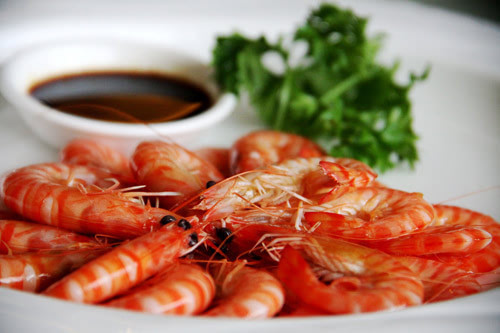
Bai Zhuo metapenaeus ensis
Ingredients: shrimp, ginger, onion, sugar, soy sauce, steamed fish and soy sauce, vinegar, salt, cooking wine, and a dozen Chinese prickly ash.
Practice:
1. Clean the shrimp, and remove the shrimp line and shrimp whiskers.
2. prepare for dipping. Chop the ginger and put it in a bowl. Then, add 1 tablespoon of white sugar, 1 tablespoon of soy sauce, 2 tablespoons of steamed fish soy sauce and 2 tablespoons of balsamic vinegar to make a bowl of juice for later use (ginger can enhance fragrance and dispel cold, so don’t omit it. There is no steamed fish soy sauce, so use soy sauce instead.
3. Pour a proper amount of water into the pot, then add 1 teaspoon of salt, 2 teaspoons of cooking wine, a few ginger slices, a few shallots and a dozen peppers.
4. After the fire boils the water, boil it for another 2 minutes.
5. Put the shrimp in the pot, boil it again and turn off the fire. Then, let the shrimp stand in the pot for 1 to 2 minutes.
6. Take out the shrimp and put it in clean water, and then change the water once or twice.
7. Dish the shrimp and dip and serve (finally, Jiang Mo in the dip can be filtered out to make it taste better).
Iv. Huaiyang cuisine
Huaiyang cuisine is a famous cuisine in the middle and lower reaches of the Yangtze River in China. It covers a wide area, including Jiangsu, Zhejiang, Anhui and Shanghai, as well as parts of Jiangxi and Henan. It has the reputation of "the best taste in the southeast" and "the most beautiful in the world", and its reputation is far spread at home and abroad.
Later, Zhejiang cuisine and Anhui cuisine became one of the eight major cuisines with their distinctive features, and Huaiyang cuisine merged in Jiangsu. At the same time, the cuisine in Jiangsu, which belongs to Huaiyang cuisine, was used to be called Jiangsu cuisine. In this way, Huaiyang cuisine became a local flavor dish with Yangzhou and Huai’ an as the center, the Grand Canal as the mainstay, Zhenjiang in the south, Hongze Lake and Huaihe River in the north and coastal areas in the east.
Signature dish: stewed lion head.
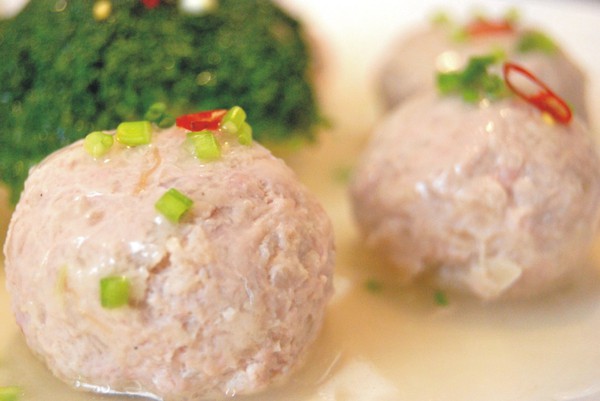
steamed minced pork balls
Ingredients: 300g pork leg, 10g mushroom, 50g water chestnut, 10g carrot, 1 egg, 15g starch, 5g sesame oil, 3g salt, 2g monosodium glutamate, 2g pepper, 15g cooking wine, 500ml chicken soup, and appropriate amount of onion and ginger.
Practice:
1. Chop mushrooms, water chestnuts and carrots for later use.
2. Shred the onion, slice the ginger and add boiling water for 10 minutes to make the onion Jiang Shui.
3. Chop the peeled pig hind leg meat into stuffing, add eggs, salt, monosodium glutamate, sesame oil, pepper and cooking wine, and stir evenly. Add onion and Jiang Shui several times and stir in one direction, then add starch and stir evenly, then add mushrooms, water chestnuts and chopped carrots and stir evenly.
4. Make the prepared meat stuffing into big balls.
5. Add chicken soup to the pot, add lion’s head, bring to a boil over high heat, and simmer for 1 hour.
6. Add rapeseed, add monosodium glutamate and salt, and season.
Five, Fujian cuisine
Fujian cuisine is a cuisine mainly formed by local flavor dishes in Fuzhou, southern Fujian and western Fujian. Fuzhou cuisine is fresh, refreshing, sweet and sour, especially paying attention to soup mixing. Another feature is that it is good at using brown sugar as ingredients, which has the functions of preventing deterioration, removing fishy smell, enhancing fragrance, improving taste and color matching.
Minnan cuisine, represented by Xiamen, also has the characteristics of freshness and lightness, and pays attention to the use of spices such as Chili sauce, mustard sauce and so on.
West Fujian is located at the junction of Guangdong, Fujian and Jiangxi provinces, with Hakka dishes as the main body, and many exotic products unique to mountainous areas as raw materials, which have a strong mountain flavor.
Signature dishes: Buddha jumping over the wall and seven-star fish balls.
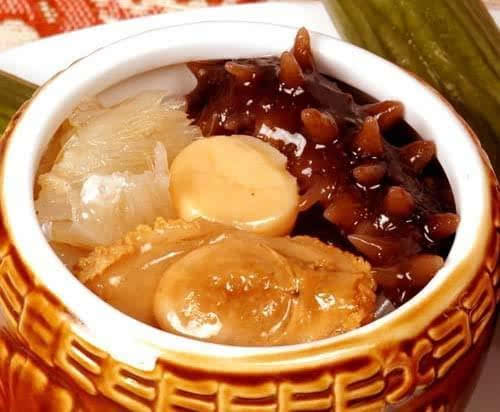
Steamed Abalone with Shark’s Fin and Fish Maw in Broth
Ingredients: 500g of shark’s fin with water, 6 clean duck gizzards, 250g of sea cucumber with water, 12 pigeon eggs, 1 clean fat hen, 200g of mushroom with water, 250g of pork tendon with water, 95g of fat pork, 1 big pig’s belly, 500g of sheep’s elbow, 150g of clean ham tendon and ginger slices. 75g of rock sugar, 125g of bream belly, 75g of superior soy sauce, 1000g of abalone, 1000g of pork bone soup, 1000g of pig’s trotters, 1000g of cooked lard and 1 duck.
Practice:
1. Remove the sand from the shark’s fin, pick it up and arrange it on a bamboo grate (a bamboo steaming tool, round or square), put it in a boiling water pot, add 30 grams of onion, 15 grams of ginger and 100 grams of Shaoxing wine, cook for 10 minutes, take it out with a fishy smell, remove the onion, ginger and juice, take it out and put it in a bowl, and put pig fat on the shark’s fin.
2. Cut the fish lips into pieces with a length of 2 cm and a width of 4.5 cm, put them in a boiling water pot, add 30 grams of onion, 100 grams of Shaoxing wine and 15 grams of ginger slices, cook for 10 minutes to remove the fishy smell, and pick out the onions and ginger.
3. Put the abalone in a steamer, steam it with strong fire, take it out, wash each piece into two pieces, put a cross knife on it, put it in a small basin, add 250 grams of bone soup and 15 grams of Shaoxing wine, steam it in the steamer for 30 minutes, take it out, and drain the steamed juice. Cooked pigeon eggs, shelled.
4. Cut off the head, neck and feet of chickens and ducks respectively. The pig’s trotters are shelled, plucked and washed. Scrape and wash the sheep’s elbows. Cut 12 pieces of each of the above four ingredients, boil them in a boiling water pot together with the clean duck gizzard, remove the blood and pick them up. Wash the pork belly inside and out, blanch it in boiling water twice, remove the foul smell, cut it into 12 pieces, put it in the pot, add 250 grams of soup, boil it, and add 85 grams of Shaoxing wine to scoop it up, and the soup is not needed.
5. Wash Stichopus japonicus and cut each into two pieces. Wash the pork trotters’ tendons and cut them into 2-inch long sections. Add 150g of clean ham tenderloin with clear water, steam it on a steamer for 30min, remove the steamed juice, and cut it into pieces with a thickness of about 1cm. Boil the winter bamboo shoots in a boiling water pot and take them out. Cut each bamboo shoot into four pieces and pat it flat. Put the pot on a strong fire. When the cooked lard is put in the pot and burned to 70% heat, fry the pigeon eggs and winter bamboo shoots in the pot for about 2 minutes and pick them up. Then, put the fish in the pot, fry until the hands can be broken, pour it into a colander to drain the oil, then soak it in clear water and take it out, and cut it into pieces with a length of 4.5 cm and a width of 2.5 cm.
6. Leave 50 grams of residual oil in the pot. When the heat is 70%, stir-fry 35 grams of onion and 45 grams of ginger slices in the pot, add chicken, duck, sheep elbow, pig’s hoof tip, duck gizzard and pork belly for a few times, and add 75 grams of soy sauce, 10 grams of monosodium glutamate, 75 grams of crystal sugar, 2,150 grams of Shaoxing wine and 500 pieces of bone soup.
7. Wash a Shaoxing jar, add 500 grams of clean water, heat it on a low fire, empty the water in the jar, and put a small bamboo grate at the bottom of the jar. First, put the cooked chicken, duck, sheep, elbow, pig’s trotters, duck gizzard, pork belly pieces, flower mushrooms and bamboo shoots, and then add shark’s fin, ham slices and scallops. After loading, put the jar on a charcoal stove, simmer it for 2 hours, then open the lid, quickly put Stichopus japonicus, tendon, fish lips and high belly into the jar, immediately seal the jar mouth, simmer it for another hour, and take it out. When serving, pour the jar mouth cabbage into a big basin, open the gauze bag and put pigeon eggs on the top. At the same time, keep up with a dish of hemp fiber radish, a dish of ham mixed with bean sprouts, a dish of fried bean sprouts with mushrooms, a dish of spicy mustard, and silver coils and sesame seed cakes.
Six, Zhejiang cuisine
Zhejiang cuisine has a long history, and its flavor includes the characteristics of dishes in Hangzhou, Ningbo and Shaoxing.
Hangzhou cuisine attaches importance to the freshness, liveliness and tenderness of raw materials, mainly fish, shrimp and seasonal vegetables, and pays attention to knife work, with fresh taste and outstanding original flavor. Ningbo cuisine is salty and fresh, and it is good at cooking seafood. It pays attention to freshness, softness and smoothness, emphasizes the original flavor and emphasizes the taste.
Shaoxing cuisine is good at cooking seafood poultry. The dishes emphasize that the entrance is fragrant, crisp and waxy, and the soup is rich in flavor and rich in rural flavor.
Signature dishes: Longjing shrimp and West Lake vinegar fish.
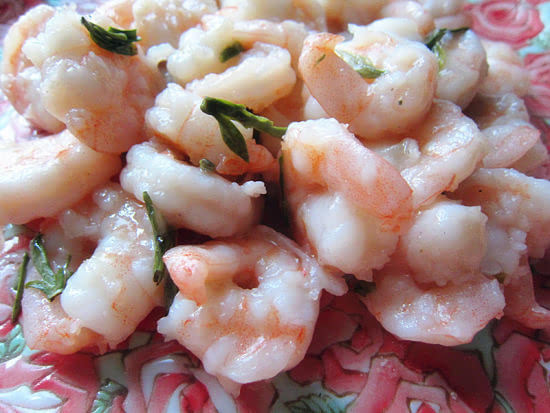
Stir-fried Shrimps with Longjing Tea Leaves
Ingredients: Longjing tea, fresh shrimp, egg white, starch, salt, monosodium glutamate and cooking wine.
Practice:
1. Soak a small amount of Longjing tea in hot water, then filter out most of the tea, leaving the amount of tea and one or two teas for later use.
2. Clean up the fresh shrimps, gut them, and dry them with paper towels.
3. Put the shrimp in a bowl, add egg white, salt and monosodium glutamate, stir until it is sticky, and then add starch.
4. Heat the oil in the pot to 50%, add the shrimps, quickly break them up with chopsticks, and pour them out for later use.
5. Put the tea in the base oil, then pour in the shrimp, stir fry, add cooking wine, salt and monosodium glutamate, and stir fry a few times.
Seven, Hunan cuisine
Hunan cuisine includes the characteristics of dishes in Xiangjiang River Basin, Dongting Lake Area and Xiangxi Mountain Area.
Xiangjiang River Basin, centered on the Yangtze River, Hengyang and Xiangtan, is the main representative of Hunan cuisine. It is characterized by strong oil color, emphasis on benefits, attention to fresh fragrance, hot and sour, soft and tender, especially for stewed vegetables and preserved vegetables.
The dishes in Dongting Lake area are good at cooking fresh river, poultry and livestock. They are characterized by large quantity, thick oil, salty, spicy and soft, and are famous for stewing and cooking.
Xiangxi cuisine is good at making delicacies, smoked bacon, all kinds of cured meat and chicken. Its taste focuses on salty, sweet and sour, and it has a strong mountain flavor.
One of the biggest characteristics of Hunan cuisine is spicy and the other is wax.
Signature dishes: Huogong stinky tofu, Donganzi chicken.
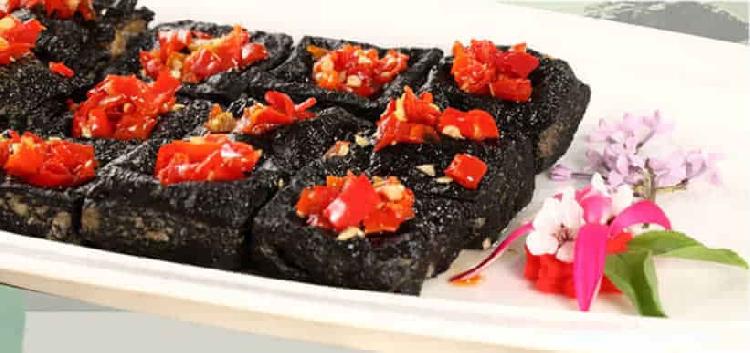
huogongdian stinky tofu
Ingredients: stinky tofu, shrimp, minced cooked ham, edamame seeds, ginger slices, bright red peppers, broth and lard.
Practice:
1. Soak the shrimps in boiling water for a while, wash the edamame seeds, and then chop the shrimps and edamame seeds. Stems and seeds of bright red peppers are removed, washed and shredded.
2. Stir-fry the dried shrimps and edamame seeds with lard, and take them out.
3. Take a long steaming tray, put stinky tofu in the steaming tray, add stock, sprinkle with minced ham, steam for about 90 minutes in a cage, then take it out, spread dried shrimps and edamame seeds, sprinkle with shredded red pepper, and steam for 10 minutes.
Eight, Anhui cuisine
The flavor of Anhui cuisine includes the characteristics of dishes in southern Anhui, along the Yangtze River and along the Huaihe River.
Southern Anhui cuisine includes Huangshan Mountain, Shexian County (ancient Huizhou), Tunxi and other places. It pays attention to fire power, is good at cooking game, is heavy in quantity and oil, simple and affordable, and maintains its original flavor. Many dishes are stewed and simmered with charcoal. The soup is clear and mellow, and the original pot is full of fragrance. Although there are not many aquatic products in southern Anhui, the cooked and salted "osmanthus fish" is well known.
The dishes along the Yangtze River are represented by Wuhu and Anqing, and later spread to Hefei. It is good at cooking fresh river and livestock, paying attention to knife work, paying attention to color and shape, and making good use of sugar to flavor, especially smoked dishes.
The dishes along the Huaihe River are represented by Bengbu, Suxian and Fuyang. The dishes are salty and spicy, the soup is thick and heavy, and coriander is also used to color matching and seasoning.
Signature dishes: Wuwei smoked duck, cloud meat.
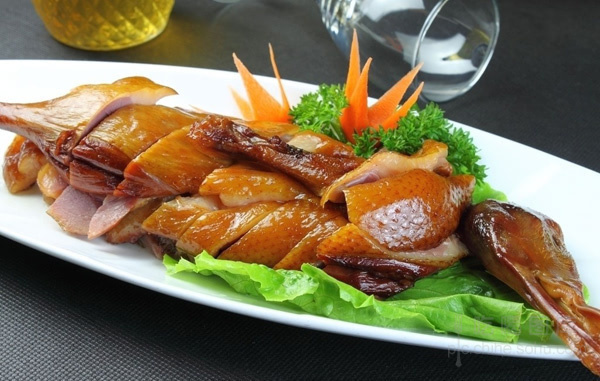
Wuwei smoked duck
Ingredients: two ducks, 100g onion slices, 100g ginger slices and 25g fennel.
Practice:
1. Clean the duck, wipe the duck thoroughly with salt, marinate it in the tank for 4 hours, and turn it once in the middle.
2. scald the duck in boiling water until the skin is tight, hang it at the tuyere and wipe off the leather coat.
3. Put four thin iron bars in the smoking pot, put the duck back down, smoke for 5 minutes, then turn over and smoke for 5 minutes.
4. Add spices, soy sauce, onion and ginger into the cauldron, bring to a boil, add the duck and stew for 45 minutes, then take it out, chop the duck into pieces and serve.
Source: China Youth Network, China Food Network, China News Network, Nanbao Network, Yangzi Evening News, Fuzhou News Network, China Weather Network, and News Evening News.